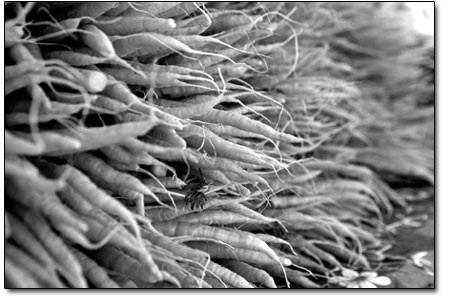|
| ||||
| Digging in SideStory: The final harvests
by Will Sands The local crop bucked all the odds in 2009. Durango’s farmers contended with a challenging growing season and changes in supply and demand in addition to a grasshopper infestation and the all-too-frequent dry spell. In spite of these difficulties, locally grown food remains stronger than ever and is continuing to find its way onto the Durango menu It goes without saying that Durango and La Plata County face unique food challenges. A short growing season, high land prices and geographic isolation have all conspired to make food – and especially locally grown food – a precious commodity on local shelves. But nowhere is this commodity in more abundance than at the Durango Farmers Market, where vendors bring an assortment of produce, meats and soft goods directly to local consumers. This summer, a record 54 vendors – most selling locally grown produce – set up each Saturday morning in the First National Bank of Durango parking lot. “We’re very lucky in Durango,” said Peg Redford, director of the Durango Farmers Market. “We have serious growers in Southwest Colorado and people who are out there truly farming and constantly innovating. I talk with people elsewhere in the state and their farmers markets are predominantly craft fairs. There just aren’t that many other people in Colorado who are actually growing food.” The Durango Farmers Market spotlighted its commitment to showcasing locally grown food when it adopted its mission statement in 1997. “It is the mission of the Durango Farmers Market to strengthen community ties to agriculture by providing a venue for regional agricultural producers to sell their products.” This year, the market expanded on that mission, and an additional seven Southwest Colorado producers set up shop at the market. “If an increase in vendors is, in fact, a sign of success, then the Durango Farmers Market is very successful,” Redford said. “We never turn farmers or growers away unless they’re from outside our radius and want to come and sell peaches from Palisade Blame it on the economy, slowdowns in tourism or changes in appetite, but the Durango customer did not seem to respond to the increase in availability. Following the final Farmers Market of the season Oct. 31, many vendors reported a drop in revenues this year over last. Where the rush on local produce used to start at 8 a.m. and the market routinely sold out by noon, this year’s market was much more sedate, according to Redford. Chuck Barry and Rosie Carter have operated Stone Free Farm since 1995 and been involved in the Durango Farmers Market since its inception. While this season proved to be a record one for Stone Free, Barry remarked that he definitely felt some of his fellow vendors’ pain. “We had a record season but know several other vendors were definitely down a bit,” he said. “There’s no doubt that there was more competition this year, but that’s also just the reality of the situation. You need to step up your game to be successful.”
Barry and Carter have been stepping up the “game” for 16 years and credit their success to Stone Free’s longevity and commitment to quality. “We’re picky about our produce and a lot of stuff doesn’t even make it to market. We also don’t experiment,” he said. “We grow what we know the market will bear.” Barry echoed Redford in saying that Durango boasts one of the top farmers markets in the state. Unlike many markets, most local vendors are devoted to growing quality food, he said, and Durangoans can tap a valuable resource every Saturday in the summer. “I think we are more fortunate than people know,” he said. “The Durango market is a standard-setting kind of market, especially for the size of the area. People need to recognize the incredible opportunity we have in this region.” Jim Dyer, of the Southwest Marketing Network, is devoted to spotlighting this opportunity. The Network is an effort to connect growers in the region and increase local agricultural production and access to locally grown foods. Dyer commented that despite this season’s hiccups, there were strong efforts toward improving food security and sustainability. Rapid growth in the Durango Farmers Market is one of the many examples of the trend, he said. “It was a tough growing year,” he said. “We had a late frost in the spring, an early frost in August, and we’re dealing with a challenging national economy. But there’s still been a continual uptick in the localization of the food supply, and it’s good to see the new vendors at the market and so many new people trying new things.” Dyer recently compiled an estimate of La Plata County’s annual grocery bill and discovered that local residents spend $130 million annually on food. This large number coupled with the capacity to grow more food in Durango paints a hopeful future for local foods, according to Dyer. “The food system is a place where people can dig in, make positive lifestyle changes and really have lasting impacts,” he said. “We’re almost at a point where we’re not just asking people to help us develop the food system, but letting the food system help the community.” However, the agricultural community is still in need of another nudge or two. That nudge could come in the form of locals stepping up and spending a few extra bucks for food that was grown down the street rather than hundreds or thousands of miles away. “There are a lot of blood, sweat and tears that go into getting food to market,” Redford said. “Once you put your own time into growing something as simple as a tomato, you can start to understand why people are charging $4 a pound.” •
|



